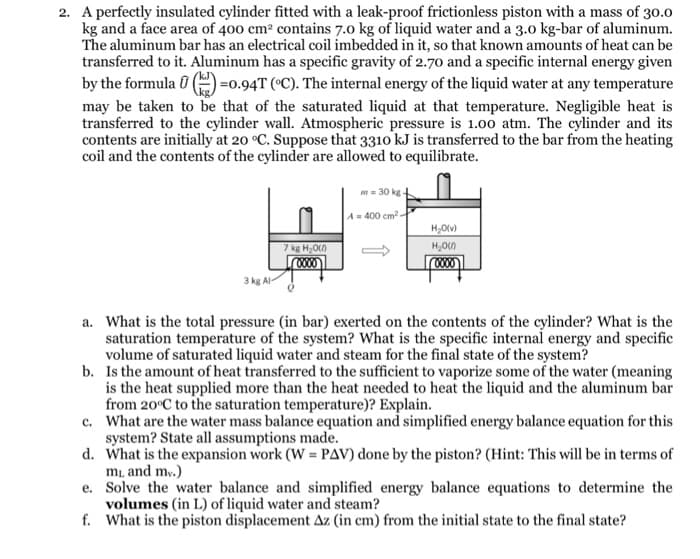2. A perfectly insulated cylinder fitted with a leak-proof frictionless piston with a mass of 30.0 kg and a face area of 400 cm² contains 7.0 kg of liquid water and a 3.0 kg-bar of aluminum. The aluminum bar has an electrical coil imbedded in it, so that known amounts of heat can be transferred to it. Aluminum has a specific gravity of 2.70 and a specific internal energy given by the formula 0 () =0.94T (°C). The internal energy of the liquid water at any temperature may be taken to be that of the saturated liquid at that temperature. Negligible heat is transferred to the cylinder wall. Atmospheric pressure is 1.00 atm. The cylinder and its contents are initially at 20 °C. Suppose that 3310 kJ is transferred to the bar from the heating coil and the contents of the cylinder are allowed to equilibrate. m= 30 kg A= 400 cm2. H,Ov) 7 kg H,O0 0000 3 kg Al- a. What is the total pressure (in bar) exerted on the contents of the cylinder? What is the saturation temperature of the system? What is the specific internal energy and specific volume of saturated liquid water and steam for the final state of the system? b. Is the amount of heat transferred to the sufficient to vaporize some of the water (meaning is the heat supplied more than the heat needed to heat the liquid and the aluminum bar from 20°C to the saturation temperature)? Explain. c. What are the water mass balance equation and simplified energy balance equation for this system? State all assumptions made. d. What is the expansion work (W = PAV) done by the piston? (Hint: This will be in terms of m, and mv.) e. Solve the water balance and simplified energy balance equations to determine the volumes (in L) of liquid water and steam? f. What is the piston displacement Az (in cm) from the initial state to the final state?
A perfectly insulated cylinder fitted with a leakproof frictionless piston with a mass of 30.0 kg and a face area of 400:0 cm2 contains 7.0 kg of liquid water and a 3.0-kg bar of aluminum. The aluminum bar has an electrical coil imbedded in it, so that known amounts of heat can be transferred to it. Aluminum has a specific gravity of 2.70 and a specific internal energy given by the formula ^ U kJ/kg?? ?? 0:94T °C??. The internal energy of liquid water at any temperature may be taken to be that of the saturated liquid at that temperature. Negligible heat is transferred to the cylinder wall. Atmospheric pressure is 1.00 atm. The cylinder and its contents are initially at 20°C. Q 3 kg Al m = 30 kg A = 400 cm2 H2O(v) 7 kg H H2O(l) 2O(l) 396 CHAPTER 7 Energy and Energy Balances Suppose that 3310 kJ is transferred to the bar from the heating coil and the contents of the cylinder are then allowed to equilibrate. (a) Calculate the pressure of the cylinder contents throughout the process. Then determine whether the amount of heat transferred to the system is sufficient to vaporize any of the water. (b) Determine the following quantities: (i) the final system temperature; (ii) the volumes (cm3) of the liquid and vapor phases present at equilibrium; and (iii) the vertical distance traveled by the piston from the beginning to the end of the process. (Suggestion: Write an energy balance on the complete process, taking the cylinder contents to be the system. Note that the system is closed and that work is done by the system when it moves the piston through a vertical displacement. The magnitude of this work is W ?? PΔV, where P is the constant system pressure and ΔV is the change in system volume from the initial to the final state.) (c) Calculate an upper limit on the temperature attainable by the aluminum bar during the process, and state the condition that would have to apply for the bar to come close to this temperature.

Trending now
This is a popular solution!
Step by step
Solved in 3 steps with 3 images


